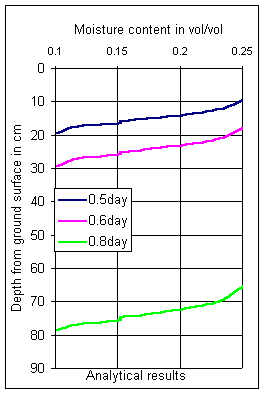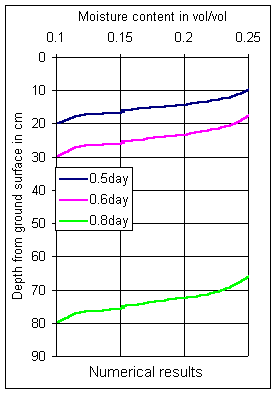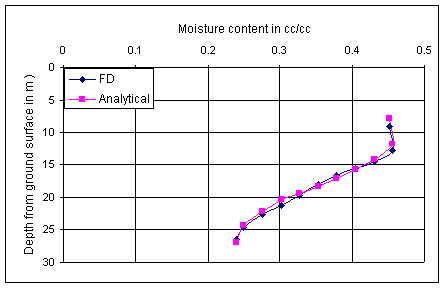| Previous Session | Paper 1 | Paper 2 | Paper 3 | Paper 4 | Paper 5 | Next Session |
SESSION-7: Monitoring and Modelling
PAPER-1: Groundwater Flow Dynamics in the Unsaturated Soil Media
Inayathulla M.*, Shivakumara I.S., Venkatachalappa M. and Ranganna G**.
CONTENTS-
Abstract
Introduction
Unsaturated Flow Model
Analytical Solution for the Unsaturated Flow Regime
Results and Discussion
References
| Abstract | up | previous | next | last |
In the design of drainage and irrigation systems, engineers (with rare exception) have made simplifying assumptions that soil is either completely saturated with water or is completely unsaturated and that resistance to flow of air (associated with the movement of water into and out of soil ) is negligible. Such assumptions are in most cases far from realistic. In real cases, there exist functional relationships among the saturation, the pressure difference between air and water, and the permeabilities of air and water. A one-dimensional flow model is developed for predicting vertical flow in the unsaturated zone of the homogenous soils. The model is developed based on the pressure head form of Richards (1931) equation. This form is chosen to couple the unsaturated flow model with saturated flow models. The analytical solution describes the development of the moisture content profile during constant infiltration and capable of predicting the time dependence of both soil moisture content and soil moisture potential.
| Introduction | up | previous | next | last |
In order to reach a phreatic aquifer, water from precipitation, from irrigation, or from an influent river, infiltrates into the ground surface and percolates downward through the unsaturated soil zone. The same is true for the pollutants carried with water. These pollutants might have already been present in water reaching the ground surface, or they may be added to the ground water by the processes of leaching, dissolution, and desorption along their path, from the ground surface to an underlying aquifer. Solid waste in landfills, septic tanks, fertilizers, pesticides and herbicides, applied over extended areas and dissolved in water applied to the ground surface, may serve as examples of sources of pollutants that travel through the unsaturated zone. Hence, the understanding of and consequently the ability to assess and predict the movement of water in the unsaturated zone is essential when we wish to determine the (total) replenishment of a phreatic aquifer as part of our groundwater flow model. Information on the movement of water is also needed in order to foretell the movement and accumulation of pollutants in the unsaturated zone and the rate and concentration at which pollutants reach the water table.
The processes within the unsaturated zone that can be expected to establish continuity of flow with the saturated zone are infiltration, gravity drainage and evaporation. The unsaturated zone is characterised by cyclic fluctuations in the soil moisture as water is replenished by rainfall (infiltration) and removed from soil profile by evapo-transpiration and gravity drainage. Unsaturated flow is usually considered as vertical flow, since gravity plays a major role during infiltration of water. In some arid regions like South India, the shortage of surface water is a major limiting factor to the economic development. In these regions, ground water is often the only source, which is replenished mainly from precipitation. To summarize the properties of the unsaturated zone as compared to the saturated zone, Freeze and Cherry (1979) state that:
• It occurs above the water table and capillary fringe,
• The soil pores are only partially filled with water, and
• The hydraulic conductivity K and the moisture content q are both functions of the pressure potential y
| Unsaturated Flow Model | up | previous | next | last |
The development and use of mathematical models for simulating and predicting water movement in soils has proliferated during the past decade. This is in recognition of the need to develop solutions for various agricultural and environmental management problems such as irrigation scheduling, pollution of surface and groundwater resources. The fundamental approach considers the fluids within the soil system to be a two-phase entity, and, accordingly, the flow equations in terms of both water and air phases (van Phuc and Morel-Seytoux, 1972) is written. Wilson and Luthin (1963); Stockinger, et al.,(1965); Bresler et al., (1971) Diment and Watson (1985) etc., have studied the behaviour of water movement in the soil experimentally. Youngs and Peck (1964) have presented a concise theoretical introduction to the interaction existing between moisture profile development and air compression during infiltration into porous media. Generally, the analysis of water movement in unsaturated porous medium usually assumes that the effect of the air phase on the flow process is negligible. Because of the large difference between the viscosities of air and water, only a small error results when the effect on the advancing wet front of the flow of the pore air is neglected.
Russo and Bouton, (1992); Clemente et al., (1994); Cresswell and Payadar (2000) etc., have presented the functional evaluation of methods for predicting the soil water characteristics. The basic relation describing the kinetics and governing equations of flow in the unsaturated zone considering unsteady multidimensional an-isotropic and non-homogeneous flow in the presence of sinks / sources are to be studied.
The governing equation for water movement in the unsaturated soil derived by Richards (1931) can be written with water content or moisture tension as the dependent variable. The one-dimensional form of Richards equation is:
![]() (1)
(1)
where q - volumetric moisture content (L 3 / L 3 );
z - depth below the soil surface (L);
K( y ) - unsaturated hydraulic conductivity( L / T ); and
![]() , Soil moisture diffusivity ( L 2 / T ).
, Soil moisture diffusivity ( L 2 / T ).
![]()
![]() . (2)
. (2)
Equation.2 represents isothermal movement of incompressible soil water in a structurally rigid porous medium. Soil-air movement is assumed to have a negligible effect on the water flow. The soil moisture characteristic curve (SMC) is assumed to be single valued, i.e., hysteresis is ignored. The soil moisture characteristic curve has the form

where a is an arbitrary constant and is defined as;
 . (3)
. (3)
Since, ![]() ,
,
We have ![]()
where, ![]() . (4)
. (4)
![]() .
.
![]() . (5)
. (5)
Taking ![]() ,
, ![]() , we have
, we have
![]() (6)
(6)
![]() . (7)
. (7)
 (8)
(8)
The general solution of Eqn.8 is:
![]() (9)
(9)
where y s is the value of y (z,t) at z = 0 .
For y < y a the Eqn.7 now becomes (after dividing by K( y ) ), :
![]() . (10)
. (10)
Taking y = f - B , and f( z ) = a + z (11)
The Eqn.10 becomes :
![]() .
.
Integrating we get,
![]() . (12)
. (12)
From Equation.11 , we have:
![]() .
.
Therefore, ![]() . (13)
. (13)
From the Darcy law, the flux of water being transmitted through the unsaturated portion of the soil profile is:
![]()
on using Equation.13, we get,
![]() . (14)
. (14)
At y = y a , Equation9 and Equation14 may be equated to get;
![]()
At z = 0 , ![]() . (15)
. (15)
Equation.15 represents the functional form of the fluid head at the surface boundary.
On substituting Equation.15 in Equation.13 we get
![]() . (16)
. (16)
In dry soil, under constant potential, y s > y a then a = 0 leads to A ( 0 ) = 0. Then Equation12 becomes:
![]() . (17)
. (17)
According to Barry et al., (1993), an explicit expression for A (t) is:
![]() (18)
(18)
where the function W(x) is defined implicitly by the equation;
![]() . (19)
. (19)
| Results and Discussion | up | previous | next | last |
Soil samples from Thirnahalli, Mallasandra and Makali villages, were collected. Suction pressure ( y m of water) for corresponding moisture contents ( q in cc/cc) were measured in the laboratory. The soil moisture curves were developed. A rigorous evaluation of several texture based regression models proposed in the literature indicated their superiority in predicting the laboratory SMC rather than the field measured one.
SMC equations for the study sites are :
(i) Tirnahalli study area, Chickballapur - ![]()
(ii) Mallasandra study area, Tumkur - ![]()
(iii) Makali village study area, Bangalore - ![]() .
.
The Unsaturated hydraulic conductivity models developed for the three-study areas are –
(i) Tirnahally Site- ![]()
(ii) Mallasandra, Tumkur - ![]()
(iii) Makali village- ![]()


Fig.1: Variation of moisture content with depth obtained from analytical and numerical model results- Thirnahalli site. (0.5day: 12 hours after start of infiltration process)

Fig.2: Variation of moisture content with depth from ground surface,
Thirnahalli /Bhairanayakanahalli site, Chikballapur
(F.D-Finite difference model)
The analytical solution developed may be applied for infiltration or capillary rise. The solution applies when the form of the soil moisture characteristic curve is a particular weighted integral of the gradient of the unsaturated hydraulic conductivity. Thus, if the soil moisture characteristic curve is selected a priori, then this condition determines the hydraulic conductivity. Fig.2 and 3 show that there is a good agreement between numerical models at different depths. The cumulative infiltration derived from the solution is of the form of Green-Ampt infiltration equation. Therefore, the analytical model is capable of incorporating soil properties ranging from weakly nonlinear to those of a highly nonlinear Green-Ampt–like model. The analytical solution describes the development of the moisture content profile during constant infiltration and capable of predicting the time dependence of both soil moisture content and potential.
| References | up | previous | next | last |
Bresler, E., Heller, J., Diner, N., Ben-Asher, I. Brandt, A. and D. Goldberg (1971): Infiltration from a trickle source: II, Experimental data and theoretical predictions. , Soil Sci, Soc. Am. J. 35: 683- 689.
Clemente, R.S., De Jong, R., Hayhoe, H.N. Reynolds, ., W.D., and M. Hares (1994): Testing and comparison of three unsaturated soil water flow models. Agricultural water management, 25: 135-152.
Cresswell, H.P., and Z. Payadar (2000): Functional evaluation of methods for predicting the soil water characteristic. J. of Hydrol. 227: 160 –172.
Diment, G.A. and K.K. Watson (1985): Stability analysis of water movement in unsaturated porous materials, 3. experimental studies. Water Resour. Res. 21(7):979-984.
Freeze, R.A., and J.A. Cherry (1979): Groundwater, Prantice Hall, Inc., New Jersey, USA
Richards, L.A (1931) : Capillary condition of liquids through porous medium. Physics 1: 318 – 333.
Russo, D. and M. Bouton (1992): Statistical analysis of spatial variability in unsaturated flow parameters. Water Resour. Res. 28(7): 1911-1925.
van Phue Le and Morel -Seytoux H.J (1972): Effect of soil air movement and compressibility of infiltration ratio. Soil Sci. Soc. Am. 36: 237- 241.
Wilson, L.G and Luthin, J.N (1963): Effect of airflow ahead of the wetting front on infiltration. Soil Sic. 96: 136 -143.
Youngs, E.G., and A.J. Peck, (1964): Moisture profile development and air compression during water uptake by bounded porous bodies; 1. Theoretical introduction. Soil Sci. 98; 290 - 294.
| Address: | up | previous |
U G C-CA S in Fluid Mechanics, Department of Mathematics, Bangalore University, Central College Campus, Bangalore – 560 001.
*Faculty of Engineering – Civil, Jnanabharathi, Bangalore University, Bangalore-560 056. Karnataka. India.
E-mail: granganna @ yahoo.com